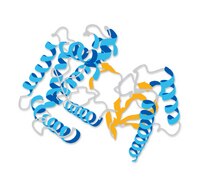375230 Sigma-AldrichHGF, Mouse, Recombinant
HGF, Mouse, Recombinant Recombinant, consists of disulfide-linked heterodimeric α (Gln33 to Arg495) and β (Val496 to Leu728) chains expressed in murine myeloma NS0 cell line.
More>> HGF, Mouse, Recombinant Recombinant, consists of disulfide-linked heterodimeric α (Gln33 to Arg495) and β (Val496 to Leu728) chains expressed in murine myeloma NS0 cell line. Less<<Synonyms: Hepatopoietin A
Recommended Products
Overview
| Replacement Information |
|---|
Key Spec Table
| Purity |
|---|
| ≥95% by SDS-PAGE as seen by a 60 kDa (α chain) and a 33 kDa (β chain) bands under reducing conditions. |
| Product Information | |
|---|---|
| Form | Solid |
| Formulation | Lyophilized from 0.2 µm sterile-filtered PBS, BSA. |
| Quality Level | MQ100 |
| Applications | |
|---|---|
| Application | HGF, Mouse, Recombinant Recombinant, consists of disulfide-linked heterodimeric α (Gln33 to Arg495) and β (Val496 to Leu728) chains expressed in murine myeloma NS0 cell line. |
| Physicochemical Information | |
|---|---|
| Contaminants | Endotoxin: <1.0 EU/µg protein |
| Dimensions |
|---|
| Materials Information |
|---|
| Toxicological Information |
|---|
| Safety Information according to GHS |
|---|
| Safety Information |
|---|
| Product Usage Statements |
|---|
| Packaging Information |
|---|
| Transport Information |
|---|
| Supplemental Information |
|---|
| Specifications |
|---|
| Global Trade Item Number | |
|---|---|
| Catalogue Number | GTIN |
| 375230 | 0 |
Documentation
HGF, Mouse, Recombinant SDS
| Title |
|---|
HGF, Mouse, Recombinant Certificates of Analysis
| Title | Lot Number |
|---|---|
| 375230 |
References
| Reference overview |
|---|
| Corso, S., et al. 2005. Trends Mol. Med. 11, 284. Karihaloo, A., et al. 2005. Nephron Exp. Nephrol. 100, e40. Urbanek, K., et al. 2005. Circ. Res. 97, 663. Hammond, D.E., et al. 2004. Curr. Top. Microbiol. Immunol. 286, 21. Rosario, M. and W. Birchmeier. 2004. Dev. Cell 7, 3. Gheradi, E., et al. 2003. Proc. Natl. Acad. Sci. 100, 12039. Chiu, S.J., et al. 2002. J. Biomed. Sci. 9, 261. Tanaka, Y., et al. 2002. Biochem. Biophys. Res. Commun. 299, 472. Maeshima, A., et al. 2000. Kid. Int. 58, 1511. Lesk, A.M. and W.D. Fordham. 1996. J. Mol. Biol. 258, 501. Saelman, E.U.M., et al. 1995. J. Cell Sci. 108, 3531. Mineo, R., et al. 1994. Endocrinology 145, 4355. Mizuno, K., et al. 1994. J. Biol. Chem. 269, 1131. Sasaki, M., et al. 1994. Biochem. Biophys. Res. Commun. 199, 772. Montesano, R., et al. 1991. Cell 67, 901. |







